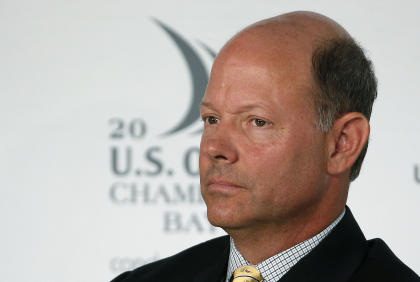The Puppetmaster: Meet the man who controls this most unique U.S. Open
UNIVERSITY PLACE, Wash. — In a moment of candor, USGA executive director Mike Davis had an epiphany like Keanu Reeves' Neo when he realized the true nature of the Matrix.
"Whatever the par is, in some ways, is irrelevant," Davis said Wednesday on the eve of the 115th U.S. Open at Chambers Bay.

For so long, the USGA has held sacred the notion of par. The thinking was: beat par in a U.S. Open and you should win, or come awfully close. However, under Davis' leadership, first as primary setup man and now also as its executive director, the U.S. Open has evolved. This week is the total embodiment of just how far Davis has been able to push the association's blue-blazered blue bloods away from the notion of what the Open should be to what it can be.
Chambers Bay represents a slew of championship firsts: the first host course in the Pacific Northwest, the first host planted with fine fescue grass, the first practically new course to host the Open in 45 years, the first Open host course built specifically for this purpose and the first Open course sporting holes with swappable par.
This Robert Trent Jones Jr. design is so flexible and offers so many different looks that Davis convinced his team not to be handcuffed by the notion of par. Hole Nos. 1 and 18, which run parallel to one another in opposite directions, can play as either a par 4 or a par 5 any day of the championship. The call was made because the holes each have two championship-worthy teeing grounds, but they're 100 yards apart. Davis wanted options to play these holes to the conditions, so the compromise? The two combined will always play to a par of 9 – never 8 or 10.
If par is fungible, then most anything is a possibility in terms of setup. The par-3 ninth has a tee box featuring a 100-foot drop to the putting surface, and another tee box, some 90 yards away from a totally different angle, that creates an uphill tee shot. Some holes could change in length by 150 yards over the course of the four championship days. The putting surfaces are enormous, giving Davis way more than the five typical choices he selects for hole locations (there's a fifth just in case there's a playoff).
In other words, Davis has more influence over this Open than any other in his tenure. Absolute power wasn't Davis' objective, but he's earned that trust. Now the hope is that the course won't be corrupted absolutely. However, Davis admitted that errors will probably be made.
"Trust me, we will absolutely, positively make mistakes this week with setup, but hopefully those are somewhat minor mistakes," he said.
The memories of Shinnecock Hills from 2004 are still vivid: groups being stopped on Sunday so that staff could water the green of the seventh hole. It's hard not to recall that visual when you see just how brown this course is.
"Right now I don't think we have an overly firm golf course," Davis said. "It's firm but I don't think we're at that point where we think we're going to lose it."
Water is Davis' secret weapon, with a massive crew constantly monitoring the putting surfaces to make sure nothing gets too wacky out here. He wants this course on the edge of fairness.
He should succeed. Davis' entire career in this role has set him up for this moment. It started with drivable par 4s and graduated rough. Then he redefined the U.S. Open tee box, forging new championship holes undeterred by anyone's idea but his of where a hole should start. Then he introduced browned-out (on purpose) fairways last year at Pinehurst, as much a statement about the USGA's vision for golf's future as it is about course difficulty.
Davis has slaughtered many of the U.S. Open's sacred cows and, in the process, put a bigger scare into golf's elite than the days of untold length, balls disappearing in the rough and greens that hold like an oil spill. Ask any pro and they'll tell you they're most afraid of what they don't see coming. Since even he's unsure of what he'll do from day to day here, Davis may as well walk around with a 1970s hockey mask and a machete. Jason Voorhees would at least want some grass to cut, not to make it practically disappear.
However, despite Tiger Woods invoking his name 10 times in his Tuesday news conference, Davis isn't God. The players will decide this championship. The fans, Davis included, will decide if it's worth supporting.
"To be honest there is some anxiousness, but there's excitement, too. I'm more excited than anything," he said. "I'm so ready to get this thing going and see what happens."
More U.S. Open coverage on Yahoo sports:
Ryan Ballengee is a Yahoo Sports contributor. Find him on Facebook and Twitter.




